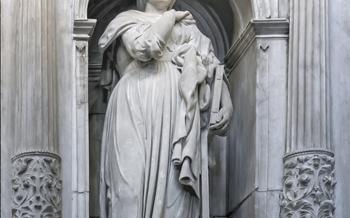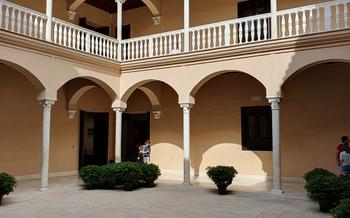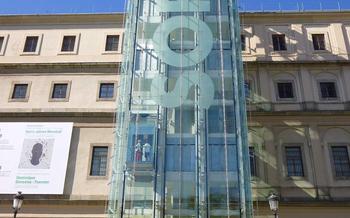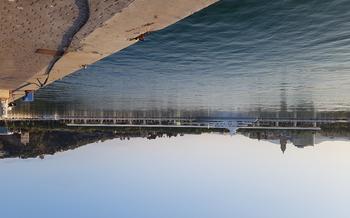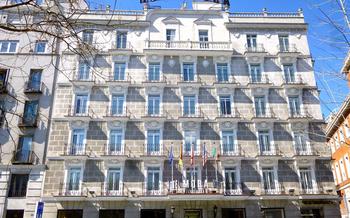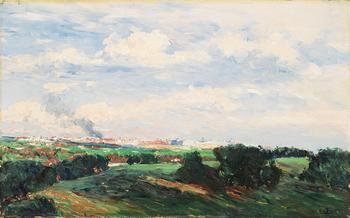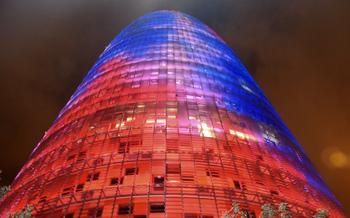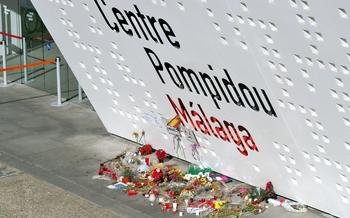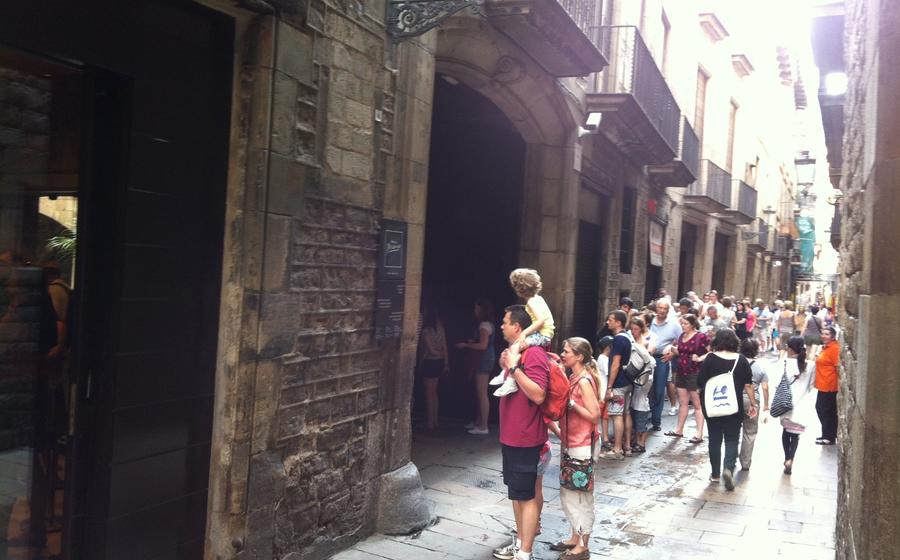
Picasso Museum
- Historical Significance
- Masterpieces
- Collections
- Temporary Exhibitions: A Window into Contemporary Art and Artistic Dialogue
- Education and Outreach
- Architecture and Design
- Interactive Experiences
- Souvenirs and Merchandise
- Accessibility
- Guided Tours
- Audio Guides
- Photography and Social Media
- Food and Drinks
- Nearby Attractions: Exploring Barcelona's Cultural Treasures
- Insider Tip: Uncovering Picasso's Hidden Masterpiece
Historical Significance
The Picasso Museum in Barcelona holds a profound historical significance, deeply intertwined with the life and career of the renowned artist Pablo Picasso. It is situated in the heart of Barcelona, within the former medieval palace known as Palau Berenguer d'Aguilar. This grand building, steeped in history and architectural charm, underwent a meticulous transformation in the 1960s to become the dedicated home for Picasso's extraordinary artistic legacy. The museum's establishment was driven by the artist's personal desire to create an institution that would showcase his vast collection of works and ensure their preservation for future generations.
The Picasso Museum serves as a testament to the artist's deep connection to Barcelona, where he spent his formative years and developed his artistic sensibilities. It houses a comprehensive collection of over 4,000 artworks, spanning various periods and styles that chronicle Picasso's artistic journey. Through these works, visitors gain an intimate glimpse into the mind and creative process of one of the most influential artists of the 20th century.
Masterpieces
Among the museum's most celebrated works is Picasso's "Las Meninas," a reinterpretation of Diego Velázquez's famous painting of the same name. Picasso's version deconstructs the original, presenting a fragmented and distorted composition that challenges traditional notions of representation. Another highlight is "Guernica," Picasso's powerful and emotionally charged response to the horrors of the Spanish Civil War. This monumental painting, rendered in shades of gray, black, and white, depicts the suffering and devastation caused by the bombing of the Basque town of Guernica.
"The Weeping Woman," a series of paintings created during Picasso's Blue Period, showcases the artist's exploration of themes of sorrow and loss. These haunting portraits capture the raw emotions of grief and despair, characterized by elongated figures and melancholic blue tones. "The Old Guitarist," another Blue Period masterpiece, portrays a solitary and introspective figure, evoking feelings of isolation and vulnerability.
These masterpieces, along with numerous other significant works, provide a comprehensive overview of Picasso's artistic journey and his profound impact on the art world.
Collections
The Picasso Museum in Barcelona boasts a diverse and comprehensive collection of the artist's works, spanning various mediums and periods of his prolific career. Paintings, sculptures, drawings, ceramics, and engravings are among the treasures housed within the museum's walls. The collection showcases Picasso's artistic evolution and experimentation, from his early Blue Period to the vibrant colors and fragmented forms of his Cubist phase.
The curatorial vision behind the organization and presentation of the collections aims to provide visitors with a chronological journey through Picasso's artistic development. The galleries are arranged thematically, allowing visitors to trace the evolution of his style and explore the different influences that shaped his work.
The museum's collection is not limited to Picasso's most famous and celebrated pieces but also includes lesser-known works that offer a glimpse into his creative process and personal life. Visitors can discover sketches, studies, and preparatory works that shed light on Picasso's artistic journey and the development of his ideas.
The Picasso Museum in Barcelona serves as a custodian of the artist's legacy, preserving and showcasing his remarkable contributions to the art world. Through its diverse collections, the museum offers visitors a unique opportunity to immerse themselves in the mind and creativity of one of the most influential artists of the 20th century.
Temporary Exhibitions: A Window into Contemporary Art and Artistic Dialogue
The Picasso Museum is not merely a sanctuary for the master's works; it is also a vibrant platform for contemporary art and artistic dialogue. The museum regularly hosts temporary exhibitions that showcase the works of established and emerging artists, shedding light on various artistic movements, themes, and perspectives. These exhibitions provide a fresh lens through which visitors can engage with Picasso's legacy and explore the dynamic evolution of art and creativity.
Past exhibitions have delved into diverse subjects, from the influence of African art on Picasso's early works to the exploration of surrealism and abstract expressionism. The museum has collaborated with renowned institutions and artists to curate exhibitions that challenge conventional narratives, spark conversations, and offer new insights into the world of art.
Upcoming exhibitions promise to continue this tradition of innovation and collaboration. Visitors can anticipate thought-provoking installations, immersive experiences, and the opportunity to engage with contemporary artists who are pushing the boundaries of artistic expression.
To stay updated on the latest exhibitions, visitors can check the museum's official website or follow its social media channels. These exhibitions offer a unique opportunity to witness the evolution of art and gain fresh perspectives on Picasso's enduring influence.
Education and Outreach
The Picasso Museum in Barcelona is committed to fostering a love and appreciation for art among people of all ages and backgrounds. To this end, the museum offers a variety of educational programs and workshops designed to engage and inspire visitors.
For younger visitors, the museum offers creative workshops that encourage them to explore their own artistic talents. These workshops may focus on a particular technique or style used by Picasso, or they may allow children to create their own works of art inspired by his masterpieces.
For older students and adults, the museum offers guided tours, lectures, and seminars that delve deeper into Picasso's life, work, and artistic influences. These programs provide a unique opportunity to learn from experts in the field and gain a deeper understanding of Picasso's contributions to the art world.
The museum also engages with the community through outreach initiatives and partnerships with local schools and organizations. These initiatives aim to bring art education to underserved communities and promote inclusivity and accessibility in the arts.
One of the most successful outreach programs is the museum's partnership with a local school for children with disabilities. Through this partnership, the museum provides art therapy and creative workshops for the students, allowing them to express themselves and develop their artistic skills.
Another notable initiative is the museum's collaboration with a local community center to offer free art classes to senior citizens. These classes provide a creative outlet for older adults and help them stay engaged and connected with their community.
Through these educational programs and outreach initiatives, the Picasso Museum in Barcelona plays a vital role in promoting art education, fostering creativity, and creating a more inclusive and vibrant cultural landscape in the city.
Architecture and Design
The Picasso Museum in Barcelona is housed in a stunning building that is a work of art in its own right. The building, known as the Palau Berenguer d'Aguilar, was originally constructed in the 13th century and has undergone several renovations and expansions over the years. The museum's current neoclassical façade was added in the 18th century, and the interior was redesigned in the 1960s to accommodate the museum's growing collection.
The museum's architecture complements the art it houses, providing a backdrop that is both elegant and understated. The grand entrance hall, with its soaring ceilings and marble floors, sets the tone for the rest of the museum, which is characterized by spacious galleries and well-lit display areas. The natural light that floods into the galleries through large windows illuminates the paintings and sculptures, allowing visitors to fully appreciate the nuances of Picasso's work.
The museum's design also includes several unique features that enhance the visitor experience. The courtyard, with its lush greenery and fountain, provides a tranquil oasis where visitors can relax and reflect on the art they have seen. The rooftop terrace offers panoramic views of Barcelona, allowing visitors to take a break from the museum and enjoy the city's vibrant atmosphere.
Interactive Experiences
The Picasso Museum in Barcelona embraces interactivity to enhance the visitor's experience and deepen their understanding of Picasso's work. Interactive elements and multimedia installations bring Picasso's art to life, allowing visitors to engage with his creative process and artistic vision.
One of the highlights is the interactive timeline that takes visitors on a journey through Picasso's life and career. Through touchscreens and visual displays, visitors can explore the different periods and influences that shaped Picasso's artistic style.
Another popular interactive feature is the virtual reality experience that immerses visitors in Picasso's studio. Visitors can don VR headsets and step into a recreation of Picasso's workspace, surrounded by his paintings, sculptures, and tools. This immersive experience provides a unique perspective on Picasso's creative environment and the inspiration behind his masterpieces.
The museum also features interactive displays that allow visitors to explore Picasso's techniques and artistic processes. For example, visitors can try their hand at creating their own Picasso-inspired artwork using digital tools and drawing tablets. These interactive experiences not only entertain but also educate, fostering a deeper appreciation for Picasso's artistic genius.
Souvenirs and Merchandise
The Picasso Museum offers a delightful array of souvenirs and merchandise for visitors to take home a piece of their experience. The museum's gift shop is a treasure trove of art-inspired products, including postcards, posters, books, and reproductions of Picasso's iconic works. Visitors can also find a selection of unique souvenirs, such as jewelry, ceramics, and home décor items inspired by Picasso's art.
These items not only serve as mementos of a visit to the museum but also contribute to the museum's sustainability and support its educational programs. By purchasing souvenirs, visitors can help ensure the museum's continued success and its ability to preserve and showcase Picasso's legacy for future generations.
Among the must-have souvenirs from the gift shop are the colorful postcards featuring some of Picasso's most famous paintings. These postcards are perfect for sending to friends and family, or for adding a touch of artistic flair to your own correspondence. For those who prefer something more substantial, the museum offers a range of art books and catalogs that delve into Picasso's life and work in greater detail.
The gift shop also offers a selection of high-quality reproductions of Picasso's paintings, allowing visitors to bring a piece of his genius into their own homes. These reproductions are created using the latest printing techniques and materials, ensuring that they faithfully capture the colors and textures of the original works.
For those looking for a truly unique souvenir, the museum offers a range of ceramics and home décor items inspired by Picasso's art. These items are handcrafted by local artisans and feature motifs and designs that echo the artist's distinctive style. From vibrant plates and vases to decorative figurines and sculptures, these items are sure to add a touch of artistic elegance to any home.
Accessibility
The Picasso Museum in Barcelona is committed to creating an inclusive environment that welcomes visitors of all abilities. The museum offers a range of accessibility features to ensure that everyone can enjoy and appreciate Picasso's artwork.
Wheelchair users and visitors with limited mobility can easily navigate the museum's galleries and public spaces. Ramps and elevators provide access to all floors, and wide doorways and corridors allow for comfortable movement throughout the museum.
The museum also provides accessible restrooms, as well as assistive listening devices for visitors with hearing impairments. For those who are visually impaired, there are tactile models of some of Picasso's most famous works, as well as audio descriptions available via the museum's app.
Additionally, the museum's staff is trained to assist visitors with disabilities and provide any necessary accommodations. Visitors can request assistance at the information desk or through the museum's website.
The Picasso Museum's commitment to accessibility ensures that everyone can have a meaningful and enriching experience while exploring the life and work of one of the most influential artists of the 20th century.
Guided Tours
Complement your visit to the Picasso Museum with an informative and engaging guided tour. These tours, led by knowledgeable and experienced guides, offer a deeper understanding of Picasso's life, work, and artistic journey.
Types of Tours
The museum provides a variety of guided tours tailored to different interests and preferences. General admission tours provide an overview of the museum's highlights, including Picasso's most famous paintings and sculptures. Specialized tours focus on specific themes or collections, such as Picasso's early works, his relationship with Barcelona, or his experimental techniques.
Benefits of Guided Tours
Guided tours offer several advantages that enhance the visitor experience. The expert guides provide insightful commentary and anecdotes, bringing Picasso's art to life and contextualizing it within the broader history of art. They also point out hidden details and lesser-known works that visitors might overlook on their own. Additionally, guided tours help manage the flow of visitors, ensuring a more intimate and personalized experience.
Visitor Insights
Visitors who have participated in guided tours at the Picasso Museum often express their appreciation for the expertise and enthusiasm of the guides. They highlight how the tours deepen their understanding of Picasso's art and his connection to Barcelona. Many visitors also mention that the tours help them discover new perspectives and insights into Picasso's creative process.
Audio Guides
Complement your visit to the Picasso Museum with an enriching audio guide experience. Enhance your understanding of Picasso's masterpieces and gain insights into his artistic journey through expert commentary. The audio guide is available in multiple languages, ensuring accessibility for visitors from diverse backgrounds. As you wander through the galleries, listen to detailed descriptions of the paintings, sculptures, and ceramics on display. The audio guide provides historical context, artistic analysis, and anecdotes about Picasso's life and influences. Whether you're an art enthusiast or a casual visitor, the audio guide offers a personalized and immersive experience, allowing you to discover the museum's treasures at your own pace.
Photography and Social Media
The Picasso Museum encourages visitors to capture and share their experiences through photography and social media. Visitors are allowed to take photographs of the museum's permanent collection for personal use, but flash photography and tripods are not permitted. The museum also welcomes visitors to share their photos and experiences on social media using the hashtag #PicassoMuseum.
When taking photos, visitors are asked to be respectful of other visitors and the artwork. It is important to avoid blocking other visitors' views or using flash photography, which can damage the artwork. Visitors are also reminded to turn off their camera's shutter sound to create a peaceful environment for everyone.
By sharing their photos and experiences on social media, visitors can help to promote the museum and its mission to preserve and showcase Picasso's legacy. The museum's social media channels are a great way to connect with other art enthusiasts, learn more about Picasso and his work, and discover upcoming exhibitions and events.
Food and Drinks
The Picasso Museum offers a delightful dining experience within its premises, allowing visitors to refuel and re-energize during their visit. The museum's café, located on the ground floor, provides a casual and inviting atmosphere to enjoy a variety of light bites, snacks, and beverages. From refreshing smoothies and juices to gourmet sandwiches and salads, the café's menu offers a selection of healthy and delicious options to suit every taste.
For a more substantial meal, visitors can head to the museum's restaurant, located on the rooftop terrace. With panoramic views of Barcelona's skyline and the surrounding Gothic Quarter, the restaurant offers a unique and unforgettable dining experience. The menu features a delectable array of Mediterranean and Catalan cuisine, showcasing the flavors and culinary traditions of the region. From traditional paella to grilled seafood and succulent meats, the restaurant's dishes are prepared using fresh, high-quality ingredients and presented with artistic flair, echoing the spirit of Picasso's works.
Whether visitors choose to indulge in a quick bite at the café or savor a leisurely meal at the restaurant, the Picasso Museum's dining options are designed to complement the overall visitor experience. With its focus on fresh, local ingredients and a menu that celebrates the vibrant culinary heritage of Barcelona, the museum's food and beverage offerings provide a delightful culinary journey that perfectly complements the artistic treasures on display.
Nearby Attractions: Exploring Barcelona's Cultural Treasures
Beyond the Picasso Museum's captivating walls, Barcelona unveils a treasure trove of cultural and historical attractions that beckon visitors to explore. A short stroll away, the awe-inspiring Gothic masterpiece, the Barcelona Cathedral, stands tall, its spires piercing the azure sky. Its intricate façade, adorned with biblical scenes and gargoyles, invites visitors to delve into its centuries-old stories. Just steps away, the Museu d'Història de Barcelona offers a journey through time, showcasing the city's rich past from Roman origins to modern-day vibrancy.
For those seeking artistic inspiration, the Picasso Museum's proximity to other renowned art galleries and museums is a true delight. The Museu Nacional d'Art de Catalunya, a short walk away, houses an impressive collection of Catalan art, spanning from medieval masterpieces to contemporary creations. The Fundació Joan Miró, dedicated to the surrealist painter, offers a unique perspective on his whimsical and dreamlike world. These cultural gems, clustered within a compact area, make it easy for visitors to immerse themselves in Barcelona's vibrant art scene.
Enhancing the cultural experience, the surrounding streets are lined with charming boutiques, independent shops, and art galleries, inviting visitors to discover unique souvenirs and local crafts. The narrow, winding alleys reveal hidden plazas, each with its own character and charm. Whether seeking culinary delights, architectural wonders, or artistic treasures, the neighborhood surrounding the Picasso Museum offers a harmonious blend of culture, history, and modern-day vibrancy, ensuring an unforgettable journey for every visitor.
Insider Tip: Uncovering Picasso's Hidden Masterpiece
Beyond the renowned masterpieces that adorn the walls of the Picasso Museum, there lies a hidden gem waiting to be discovered. In a secluded corner of the museum, tucked away from the bustling crowds, you'll find a small, unassuming painting that holds a captivating story. Depicting a serene landscape with a solitary tree, this enigmatic work is believed to be one of Picasso's earliest and most personal creations. It offers a rare glimpse into the artist's formative years and the development of his unique style. Seek out this hidden treasure during your visit to the Picasso Museum for an intimate encounter with the genius of the master himself.

